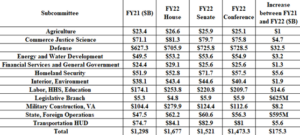Welcome to the March edition of A Capitol View. This edition includes news from Congress on FY22, updates from the Department of Energy on lithium investments, the President’s FY23 budget request, US Army priorities, and plans to reopen the Capitol.
FY22 Appropriations Bills Passed and Signed
On March 10, Congress passed the FY22 omnibus budget that included all 12 appropriations bills and sent it to President Biden’s desk, who signed the $1.5 trillion omnibus package to fund the government for the remainder of FY22. The final budget contains a $142.8 billion increase in non-defense discretionary spending, a $32.5 billion increase in defense spending, and an additional $13.6 billion for Ukraine. Below is a breakdown of the top-line numbers from the 12 appropriations bills.

President Biden Delivers FY23 Budget to Congress
On March 28, President Biden sent his proposed FY23 budget to Congress, formally kicking off the new appropriations cycle. The long-awaited budget proposes a total of $5.8 trillion in federal spending for fiscal year 2023, which begins on October 1, 2022. While the majority of that balance goes towards Medicare, Medicaid, Social Security, and net interest on the national debt, all of which is considered “mandatory spending,” roughly $795 billion (5.6% increase over FY22) will go towards discretionary defense spending and $915 billion (18% increase over FY22) will go towards domestic programs. These are notable increases and this budget will determine the administration’s priorities heading into the 2022 midterms.
The House and Senate Budget Committees will now turn their attention to reporting budget resolutions to break down funding levels for their respective Appropriations Committees and 12 subcommittees. Once that is completed, Congress will begin drafting appropriation bills. These bills will include programmatic funding requests submitted by Members.
US Army Priorities for the 21st Century
Climate Strategy
 In February, the Army released its 2022 Climate Strategy. The strategy identifies vehicle fuel efficiency and electrification, operational power generation, battery storage, land management, procurement, supply chain resilience, and workforce development as some of its top focus areas. The Army also plans to continue working towards reducing its energy and other natural resource consumption during its operations, including attaining net-zero GHG emissions by 2050. The report also acknowledges the potential risks of climate change, including energy and water scarcity, damage to installations and infrastructure, displacement and disruption of operations, supply chains, and logistics, and the health of soldiers. To mitigate and adapt to the threat of climate change, the Army plans to focus on three Lines of Effort (LOE). These LOEs focus on installations, acquisition & logistics, and training, for each of which the Army outlines its goals and efforts that together make up a unified plan for climate change adaptation and mitigation.
In February, the Army released its 2022 Climate Strategy. The strategy identifies vehicle fuel efficiency and electrification, operational power generation, battery storage, land management, procurement, supply chain resilience, and workforce development as some of its top focus areas. The Army also plans to continue working towards reducing its energy and other natural resource consumption during its operations, including attaining net-zero GHG emissions by 2050. The report also acknowledges the potential risks of climate change, including energy and water scarcity, damage to installations and infrastructure, displacement and disruption of operations, supply chains, and logistics, and the health of soldiers. To mitigate and adapt to the threat of climate change, the Army plans to focus on three Lines of Effort (LOE). These LOEs focus on installations, acquisition & logistics, and training, for each of which the Army outlines its goals and efforts that together make up a unified plan for climate change adaptation and mitigation.
Service Priorities
The Center for Strategic and International Studies (CSIS) hosted a webinar that featured General James C. McConville, the Army Chief of Staff, to discuss the service’s short and long-term priorities. CSIS’s Senior Advisor Mark Cancian hosted the session to discuss the Army’s priorities of people, readiness, and modernization. Furthermore, they discussed specific topics such as Project Convergence, key modernization programs including Long-Range Precision Fires and Future Vertical Lift, and the upcoming FY23 budget.
Budget Items
Recent cuts to readiness and modernization have required the Army to be more selective towards future programs, reliant on incrementally improving enduring systems, and cautious when phasing out legacy systems. Legacy systems, however, while capable, can pose a threat to the lives of service members due to outdated technology and age. Investments in improved readiness and modernization can prime the force to improve supply chain efficiency, soldier lethality, and deployment capability. With these recent trends, the Army has been taking a new approach to acquisitions and RDT&E programs by soliciting ideas to industry and testing prototypes before signing long-term, expensive contracts in order to improve the endurance of these potential programs, such as the recent draft Request for Proposal (RFP) for the Optionally Manned Fighting Vehicle (OMFV) program.
Modernization Programs
Of the 31+4 (35) modernization programs and priorities outlined, 24 of those efforts will be delivered in 2023. Many will be programs of record and in the hands of soldiers for training and deployment purposes by 2023. Key programs/priorities outlined by General McConville include:
Long-Range Precision Fires (LRPF)
- Extended Range Cannon Artillery (ERCA), Hypersonic Missile Battery, Prism Strength Missile Battery, Midrange Battery, etc. Mission-critical to multi-domain task force operations.
Next-Generation Combat Vehicle (NGCV)
- Even with speculation of modernization cuts, General McConville firmly believes that due to the army being ‘personnel driven,’ the NGCV is crucial to protecting soldiers.
Future Vertical Lift
- Faster aircraft with greater range can replace legacy rotary-winged aircraft granting greater efficiency to Army deployment and supply chains.
The “Network” (Project Convergence/JADC2)
- This will be integral to an effective air and missile defense strategy, as well as against an unmanned aerial threat. Ex. (Multiple air and ground sensors will pick up the threat that will transfer information back to the battle command system, enabled by Artificial Intelligence that plugs the data into the right weapons system).
Air and Missile Defense
- Project Convergence and the overall network will be crucial for air and missile defense. Different weapons systems to eliminate targets, depending on size and threat, could include the Patriot Missile, THAAD, high-energy microwaves, gun systems, direct-energy systems, and more.
While these may be the US Army’s key programs for the foreseeable future, they have other priorities and programs of note that include hypersonics, robotics, unmanned systems, Integrated Visual Augmentation System (IVAS), and talent management.
US Capitol to Reopen to the Public on March 28 After Two Years

After more than two years of the people’s house being closed to the public due to the pandemic and Capitol police shortages, stewards of the Capitol unveiled a tentative reopening plan that will consist of two phases. House Sergeant-at-Arms William Walker and Capitol physician Brian Monahan announced in a memo that the public reopening will take place gradually over the course of the next few months. “We appreciate your continued patience and cooperation as we work together to resume public tours of the Capitol for the American people in a way that protects the health and safety of visitors and institutional staff alike,” wrote Walker and Monahan in their reopening memo. The plan was designed, developed, and formally approved by members of the Capitol Police Board, which includes the House and Senate Sergeant-at-Arms and the Architect of the Capitol. The outlined plan is below:
Phase One
As of March 28, lawmakers and staff are limited to a maximum of 15 people in a tour group and must make reservations through the Capitol Visitor Center. Congressional offices will only be able to reserve one tour per week. They will also be able to reserve exclusive tours of the Capitol dome, limited to seven guests, starting April 25. Not all parts of the Capitol will be accessible to tours through phase one.
Phase Two
On May 30, the Capitol Visitor Center will reopen with limited access. In the memo, they highlighted that other areas that were previously inaccessible would be expected to reopen to visitors during this phase. Additionally, the US Botanic Garden will fully reopen on April 1.
Lithium Batteries Investment by the Department of Energy

On Friday, March 18, the Department of Energy announced a $5 million investment in support of the emerging lithium battery industry workforce. In partnership with the Department of Labor and the AFL-CIO, the Department of Energy will use the $5 million to fund up to five pilot programs within the energy and automotive sectors. These programs will focus on fostering relationships between manufacturing companies and organized labor, and training providers to develop a strong lithium battery workforce development strategy. The operations of these five pilot programs will inform the creation of a larger, permanent lithium battery workforce development program in time to align with historic federal investments in domestic battery manufacturing and recycling.
This announcement is the latest of a series of investments in Appalachian workforce development from President Biden’s newly formed Interagency Working Group on Coal and Power Plant Communities and Economic Revitalization. The group seeks to transition the nation towards a clean energy economy through workforce development and other economic revitalization programs and has highlighted investments into coal-dependent communities in Appalachia and rural America as a key priority.




